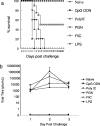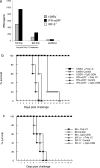Induction of innate immunity against herpes simplex virus type 2 infection via local delivery of Toll-like receptor ligands correlates with beta interferon production
- PMID: 17005672
- PMCID: PMC1617293
- DOI: 10.1128/JVI.01036-06
Induction of innate immunity against herpes simplex virus type 2 infection via local delivery of Toll-like receptor ligands correlates with beta interferon production
Abstract
Toll-like receptors (TLRs) constitute a family of innate receptors that recognize and respond to a wide spectrum of microorganisms, including fungi, bacteria, viruses, and protozoa. Previous studies have demonstrated that ligands for TLR3 and TLR9 induce potent innate antiviral responses against herpes simplex virus type 2 (HSV-2). However, the factor(s) involved in this innate protection is not well-defined. Here we report that production of beta interferon (IFN-beta) but not production of IFN-alpha, IFN-gamma, or tumor necrosis factor alpha (TNF-alpha) strongly correlates with innate protection against HSV-2. Local delivery of poly(I:C) and CpG oligodeoxynucleotides induced significant production of IFN-beta in the genital tract and provided complete protection against intravaginal (IVAG) HSV-2 challenge. There was no detectable IFN-beta in mice treated with ligands for TLR4 or TLR2, and these mice were not protected against subsequent IVAG HSV-2 challenge. There was no correlation between levels of TNF-alpha or IFN-gamma in the genital tract and protection against IVAG HSV-2 challenge following TLR ligand delivery. Both TNF-alpha(-/-) and IFN-gamma(-/-) mice were protected against IVAG HSV-2 challenge following local delivery of poly(I:C). To confirm that type I interferon, particularly IFN-beta, mediates innate protection, mice unresponsive to type I interferons (IFN-alpha/betaR(-/-) mice) and mice lacking IFN regulatory factor-3 (IRF-3(-/-) mice) were treated with poly(I:C) and then challenged with IVAG HSV-2. There was no protection against HSV-2 infection following poly(I:C) treatment of IFN-alpha/betaR(-/-) or IRF-3(-/-) mice. Local delivery of murine recombinant IFN-beta protected C57BL/6 and IRF-3(-/-) mice against IVAG HSV-2 challenge. Results from these in vivo studies clearly suggest a strong correlation between IFN-beta production and innate antiviral immunity against HSV-2.
Figures






Similar articles
-
NK and NKT cell-independent contribution of interleukin-15 to innate protection against mucosal viral infection.J Virol. 2005 Apr;79(7):4470-8. doi: 10.1128/JVI.79.7.4470-4478.2005. J Virol. 2005. PMID: 15767447 Free PMC article.
-
Toll-like receptor (TLR)-3, but not TLR4, agonist protects against genital herpes infection in the absence of inflammation seen with CpG DNA.J Infect Dis. 2004 Nov 15;190(10):1841-9. doi: 10.1086/425079. Epub 2004 Oct 18. J Infect Dis. 2004. PMID: 15499542
-
Role of IFN-alpha/beta signaling in the prevention of genital herpes virus type 2 infection.J Reprod Immunol. 2007 Jun;74(1-2):114-23. doi: 10.1016/j.jri.2006.09.002. Epub 2006 Nov 7. J Reprod Immunol. 2007. PMID: 17092567
-
The role of toll-like receptor ligands/agonists in protection against genital HSV-2 infection.Am J Reprod Immunol. 2008 Jan;59(1):35-43. doi: 10.1111/j.1600-0897.2007.00558.x. Am J Reprod Immunol. 2008. PMID: 18154594 Review.
-
The potential of immunostimulatory CpG DNA for inducing immunity against genital herpes: opportunities and challenges.J Clin Virol. 2004 Jul;30(3):207-10. doi: 10.1016/j.jcv.2004.03.001. J Clin Virol. 2004. PMID: 15135735 Review.
Cited by
-
IFN-α subtypes: distinct biological activities in anti-viral therapy.Br J Pharmacol. 2013 Mar;168(5):1048-58. doi: 10.1111/bph.12010. Br J Pharmacol. 2013. PMID: 23072338 Free PMC article. Review.
-
Genital HSV-2 infection induces short-term NK cell memory.PLoS One. 2012;7(3):e32821. doi: 10.1371/journal.pone.0032821. Epub 2012 Mar 22. PLoS One. 2012. PMID: 22457721 Free PMC article.
-
The Dual Nature of Type I and Type II Interferons.Front Immunol. 2018 Sep 11;9:2061. doi: 10.3389/fimmu.2018.02061. eCollection 2018. Front Immunol. 2018. PMID: 30254639 Free PMC article. Review.
-
Recent insights into the role of Toll-like receptors in viral infection.Clin Exp Immunol. 2010 Sep;161(3):397-406. doi: 10.1111/j.1365-2249.2010.04196.x. Clin Exp Immunol. 2010. PMID: 20560984 Free PMC article. Review.
-
OASL1 deficiency promotes antiviral protection against genital herpes simplex virus type 2 infection by enhancing type I interferon production.Sci Rep. 2016 Jan 11;6:19089. doi: 10.1038/srep19089. Sci Rep. 2016. PMID: 26750802 Free PMC article.
References
-
- Akira, S., and K. Takeda. 2004. Toll-like receptor signalling. Nat. Rev. Immunol. 4:499-511. - PubMed
-
- Akira, S., K. Takeda, and T. Kaisho. 2001. Toll-like receptors: critical proteins linking innate and acquired immunity. Nat. Immunol. 2:675-680. - PubMed
-
- Ashkar, A. A., X. D. Yao, N. Gill, D. Sajic, A. J. Patrick, and K. L. Rosenthal. 2004. Toll-like receptor (TLR)-3, but not TLR4, agonist protects against genital herpes infection in the absence of inflammation seen with CpG DNA. J. Infect. Dis. 190:1841-1849. - PubMed
Publication types
MeSH terms
Substances
LinkOut - more resources
Full Text Sources
Other Literature Sources
Medical
Molecular Biology Databases

